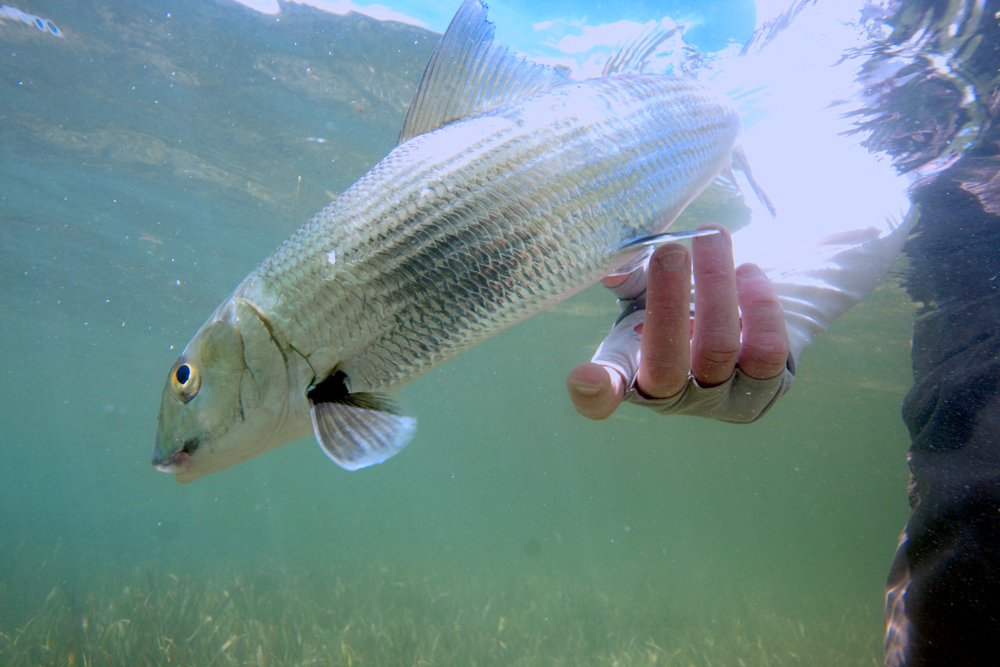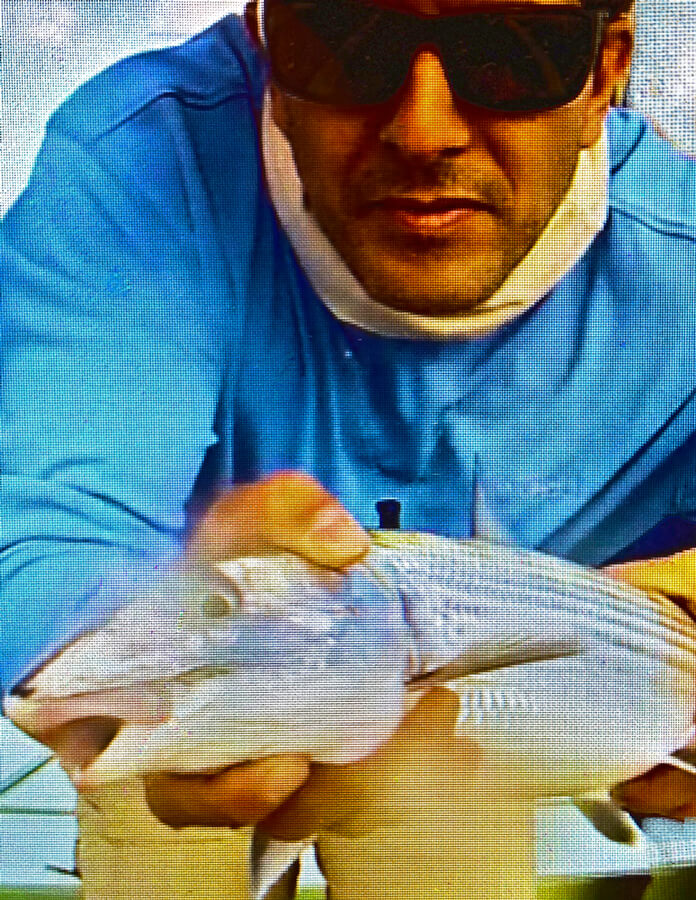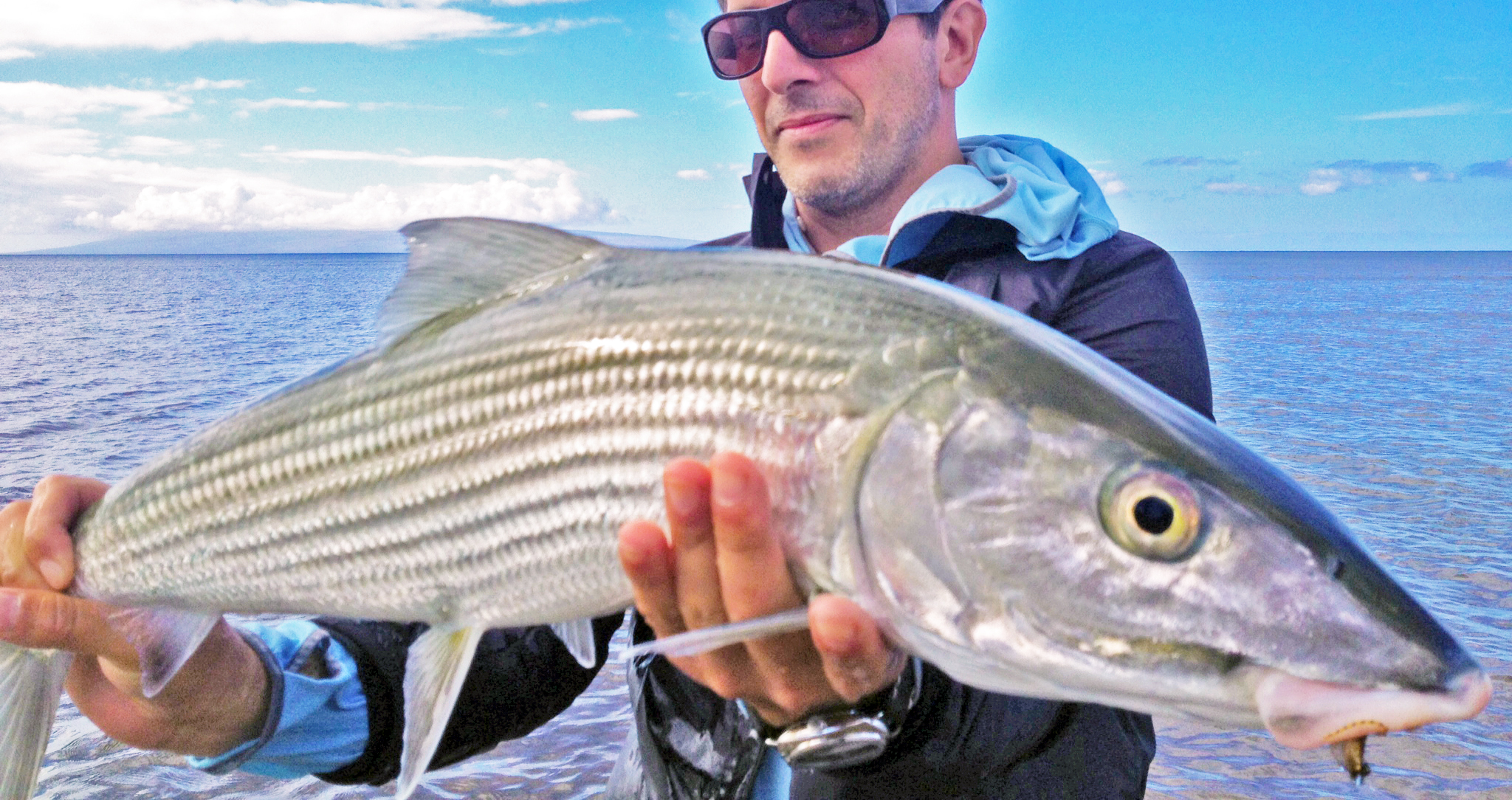Addiction
by Joseph Ballarini
On my first cast to a bonefish, on Biscayne Bay near Miami in August 2008, I hooked up.
We rolled out of Black Point Marina, into a skinny-water eel grass flat that was as smooth as melted glass. The sun was starting to surface in its awesome orange glow, illuminating the horizon. We saw spiders the size of birds high up in the mangroves in the early morning light; there may have been a bird caught in one of the webs. What am I doing here?
We traveled by canoe through a very small creek. It was shallow, muddy, smelled like sulfur, and there were lots of bugs. What was I thinking this morning?
The creek fed into a small cove named Black Point about 10 miles south of Miami Beach. As I was admiring the sunrise, just as we entered the creek mouth onto the flats, the guide whispered, “See them? There they are!”
I was nervous—very nervous. I had just started fly fishing after being a bait chucker since age four, and frankly, my fly casting wasn’t good. “I’ll get you closer,” the guide said. “Get ready to cast.” My heart was racing at about 120 beats per minute. I felt my palms getting sweaty, and the grip on my cork handle started to loosen. The cork was indented from the raw pressure of my grip, but it just didn’t seem tight enough, so I just kept squeezing. My body felt heavier, and there was little I could do about it.
“Twelve o’clock, about 45 feet. See them?”
I did. There were six or seven big bonefish right in front of me—tailing. I’d never seen them tail at such short range. This was my chance to catch my first bone on a fly. I was excited, and I could taste success.
I completely flubbed the first cast, throwing the fly about 20 feet short and about 30 feet to the left of the school. I picked up my line with a water haul, which at that moment I really didn’t know existed. Somehow, maybe with the adrenaline or just plain luck, I fired a 40-foot laser into the center of the small school of tailing bones. I saw a flash of silver and heard the guide scream, “He ate it! Set it! set it!”
 Huge Fish and a Bad Knot
Huge Fish and a Bad Knot
I pulled back on the line and set the hook on a roughly 7-pound bonefish. My rod bent like I had never seen it bend—because I had never had a fish of that brawn on it before. With the reel screaming, the mighty bone pulled off about 150 feet of line in a blazing initial run that only took seconds.
“You are the luckiest guy in the world,” my guide bellowed. “No one catches a bonefish on their first cast.” Technically, it was my second cast, but it didn’t matter. As quick as the fish was hooked, it was gone. My knot gave way, leaving a pig-tailed leader shooting back at the canoe. I quickly retrieved my line, and the guide grabbed it for a closer look.
“You need to check your knots, man,” he said. “You just lost a huge fish because of a knot.”
I had a pit in my stomach, and for the first time since I was four years old, I didn’t want to fish anymore. That was probably good, because there weren’t any more fish that morning. I felt like a complete failure, but there was a part of me that thought I could do it again. The optimism kept me coming back.
Finally, near Matheson Hammock in Miami, it happened again. It was the same scenario,
but I had been fishing without a guide for about a week. I launched my kayak from the public beach on a pebble shore which wasn’t far from a channel. It was overcast and warm for the time of year, the tides were very dramatic, and there was rain on the horizon. Only lightning would make me leave the flats, especially after waking up at 4:30 a.m. to get on the water by sunrise. But indeed, there was lightning amid the raid on the distant horizon. I didn’t have much time. My favorite 8-weight was ready, handle at my feet with the tip off the bow. This time I tied my own leader and checked my knots twice. I even tied my own fly, Peterson’s Spawning Shrimp, my go-to bonefish fly at the time.
While poling my kayak over a deep boat channel, I saw something in the distance. There they were—six or seven bonefish tailing in about a foot of water on an eel grass flat. They were fat and happy. It almost looked like the same school as that first connection, but the chance of that was virtually nonexistent.
Here we go again
I pole with a rope looped around my wrist. The rope is tied to the anchor line, which allows me to loop the rope around my push pole and gently drop it behind the kayak to drag behind my vessel, well out of the way. I pushed hard one more time to get into a better position.
I looped my rope, dropped the pole, picked up the fly rod, and attempted to visualize my attack.
This time I was ready. Calmer, more experienced, and a much better caster, but still no bones to date, so the nervousness persisted to a significant degree. In this moment, you just accept the tachycardia and sweaty palms, knowing that the hunt is on.
I began my cast, very sloppy and too fast on the backcast, which seems to be the norm while casting when fish are actually present. I threw a 35-foot lob that hit the water like a rock, just to the right of the tailing fish. Fortunately, they were just starting to move right. Sometimes it’s better to be lucky than good.
There was almost no light, so little that I was surprised I saw them in the first place. I couldn’t see what was going on, but before I could react, something took the fly, and a fish was on.
Again the rod had a ferocious bend and a crazy bounce. But this one wasn’t as big as that first hooked bonefish. It took off into the boat channel that I had just crossed, and before I knew it, it was well into the holy crap part of my backing. Over 250 feet of backing was gone, and at no point did I have any control of the fish.
Then it stopped suddenly. My heart sank as I thought the fish was lost. In frustration, I began to reel as fast as my hand could move and watched the kayak start to drift toward the direction
of the fish’s run. It was still on. In a few minutes I had retrieved my backing and was back to fly line, but at that point the resting fish recovered.
Another screaming run began and soon put me back into holy crap territory. I noticed that the lightning, which had been far off on the horizon, was much closer, and rain began
to fall. I was standing on a kayak in Biscayne Bay in a lightning storm fighting a bonefish that just wouldn’t make it easy. I debated whether I should break it off and head for shore, but my ego got the best of me, and I refused to let it go. I was tired of failure and frustration, and I was going for broke. Succeed or die trying, which in retrospect was incredibly stupid.
I started to pressure the fish hard. Really hard. I was expecting him to break off at any moment and become another “almost” story. To my amazement, however, he began to wilt. He lost his mojo and any desire to fight. Again, my heart raced. I could taste success.
Within five minutes, my leader was to the tip, and I had a bonefish—my first bonefish—to the
side of the kayak. He had surrendered. Soaking wet from the rain, not remotely concerned about the lightning, I pulled him out of the water, so excited that I dropped my rod in the
water. But it didn’t matter.
There it was—mirrored silver scales, blackish green stripes, unrealistic pink lips, and my
Peterson’s spawning shrimp stuck in its top lip. It was slippery, slimy, and stinky, but it was a bonefish, caught on a fly, finally, in my hands.
It was glorious. The most beautiful fish I had ever seen. I just stared at it, taking in the details for too long before realizing it was raining hard, there was lightning nearby, and this poor bonefish couldn’t breathe. I lunged for the camera for a quick photo, but to my dismay the battery was dead. Adding more insult, I dropped the fish in the water and stepped on the fly. I can be such a bonehead.
One rookie mistake after another. But after months of frustration, repeated failure, and countless hours of research and investigation, I had just caught my first bonefish on a fly. I soon realized this was more than an obsession. Perseverance in the face of constant failure and determination to succeed had turned my obsession into a healthy addiction.
I still had so many questions. Why was it so hard to find good information about fly fishing in salt water? Why did it take me more than six months to land a bonefish when I’d been
fishing my whole life? Where are other places to fish? What other species are as challenging? Where can I get really solid advice and real data? I didn’t have any answers. Then it hit me. I’m a bonehead … a fly fish bonehead.
A quest in earnest
While heading back to my truck, riding the high of catching my first bonefish on a fly, lingering questions substantially limited my joy. My father had me out fishing since I was four; it was something I had been doing my entire life. Why did I have such a hard time catching a bonefish?
Was this the pinnacle of my fishing experience? Are other fish going to be as difficult?
What other fish are out there?
Well, I found other fish, plenty of them: tarpon, permit, snook, tuna, shark, barracuda, billfish, and roosterfish. There are milkfish, trevally and queen fish in Australia. There are fish similar to permit in Asia, as well as a fish in the Indo-Pacific called snub-nose pompano. Hawaii has giant bonefish. There are many targets for fly anglers. Each one requires a fair amount of knowledge and competence.
So my search for competence began, emphasis on “search.” There were hundreds if not thousands of websites for fly fishing. To my dismay, most of them were utterly useless. I found plenty of dead links and lots of self-serving information that was just trying to sell products or book a trip.
My research and quest for knowledge was stymied by a glaring lack of good information. I wanted data on species, migration patterns, typical foods, which flies mimicked which foods, destinations, weather conditions, and tides. It was stuff I couldn’t find without reading hundreds of pages and rooting through piles of garbage. The internet was full of information that was mostly unorganized, incomplete, and inaccurate, and there were a lot of people masquerading as authorities.
I remember searching for “bonefish fly” and getting results for nymph fishing in Pennsylvania.
Trout fishing is fun, but I wanted to learn about saltwater fly fishing and get better at it.
I wanted to learn how to fly fish effectively in salt water for the top ten or 15 species. One fish in six months—that’s not fun, but it was a learning process. I was done putting in time and paying dues. The addiction had taken over now; I wanted to hunt for fish, not information.
For the next 18 months, I researched saltwater fly fishing information and began to create database. I fished with every captain that I could from Florida to the eastern Caribbean, from California to Australia, and made notes and took photos and video. My travels took me to the Florida Keys, Panama, Costa Rica, Mexico, California, Australia, the Bahamas, the Windward Islands—anywhere to learn. And I did just that.
I practiced casting and specific techniques for casting in wind and less desirable conditions. I began studying the art of fly tying and collected flies from all over the world.
My science background enabled me to search data, organize it, and understand it. It became more of a study of the species and the ecosystems that they inhabit rather than a fly fishing study. If you understand the behavior of the fish, then you understand how to target and hunt for that fish. If you know a species’ migration patterns, for example, why would you need fishing calendar?
I gathered a lot of solid knowledge from all of that traveling, as well as many tips and tricks, and most important, an understanding of how to read water and how to read fish. During my travels and time on the water, perhaps the biggest thing I learned was that our waters are in trouble. It was all too common to hear captains talk about how plentiful the oceans used to be.
Seeing debris washed up on scenic Caribbean beaches and even in Biscayne Bay, polluting the system and endangering the wildlife, was troubling. Rips and scars in the sea grass and on manatees from the carelessness of recreational motor boaters. It’s just a matter of time before it’s all gone.
Every time I go out fishing on the kayak, I come home with a bag of trash. Not my trash, but trash that was floating in our water that I collected for proper disposal. I can’t tell you how many beer bottles, plastic bags, and chunks of Styrofoam I’ve collected.
I found that not only was I becoming a knowledgeable fly fisherman, but also an informed and very concerned guardian of the ecosystems the fish inhabit. I wanted to make people aware of the problem and do something to help support the trusts that study and protect the waters and species.
 And so it began
And so it began
This was the catalyst for Flyfishbonehead. “Hunt for fish, not information.” That’s catchy, but there’s a bigger goal. Let’s create awareness of dangers posed to our ecosystems. Perhaps we can create a global network of members, and maybe this network can make a difference.
What if I could create a website with accurate, organized information that promotes the sport of fly fishing in salt water and supports the charitable trusts that support the ecosystems?
So I did.
In 2010, I started organizing my database and planning a website. I had thousands of photos and hours of video: tuna, blue marlin, sailfish, roosterfish, all kinds of sharks, striped bass, weakfish, bluefish, tarpon, bonefish, trevally. I had so much information to sort. It was overwhelming at first, but after a few years and many terabytes of storage, it’s now somewhat manageable. And I’ve kept fishing and traveling.
My friends and fishing buddies were initially a bit concerned about my “addiction.” They later recognized that it had become a healthy outlet for the good of the sport and the environment, and they began to help. Like old college buddies chanting “chug, chug, chug,” they kept me moving forward and contributed as much as they could, and in 2011, we created Flyfishbonehead.com and Tail Fly Fishing Magazine.
Little did I know how insanely difficult it was going to be to launch a website and magazine. With so many details, countless considerations, photos and videos to edit and process, writing copy, and verifying copy to ensure accuracy, there wasn’t enough time in the day to get everything done. We wanted it to be great; everything had to be perfect. But it didn’t work out that way.
We were almost a month behind schedule, and due to some major obstacles and a few failed designs, it was another year until Tail Fly Fishing Magazine launched in August 2012 during the beta trial of Flyfishbonehead.com.
In September 2012, the beta tag came off, and Flyfishbonehead.com was finally officially launched. My addiction was fly fishing for bonefish, but now it has become fly fishing and also making sure future generations of fly anglers get to enjoy the same waters and experiences that we now enjoy. Perhaps together, as a global fly fishing community, we can even make it better.
I still remember catching that first bonefish. Almost getting struck by lightning. Dropping a Sage rod in the bay. Stepping on the fly and hooking my foot. I’m a bonehead….a fly fish bonehead. You’d think that would’ve been enough to make me quit. But addiction is a very strange thing.


